
Manzanita is a common name for many species of the genus Arctostaphylos. They are evergreen shrubs or small trees present in the chaparral biome of western North America, where they occur from Southern British Columbia and Washington to Oregon, California, Utah, Arizona, New Mexico and Texas in the United States, and throughout Mexico. Manzanitas can live in places with poor soil and little water. They are characterized by smooth orange or red bark and stiff, twisting branches. There are 105 species and subspecies of manzanita, 95 of which are found in the Mediterranean climate and colder mountainous regions of California, ranging from ground-hugging coastal and mountain species to small trees up to 20 feet (6m) tall. Manzanitas bloom in the winter to early spring and carry berries in spring and summer. The berries and flowers of most species are edible.

Genista monspessulana, commonly known as French broom, Montpellier broom or Cape broom (Australia), is a woody leguminous perennial shrub. The yellow-flowering bush is native to the Mediterranean region, and while it may still be commonly sold in some garden stores, it is considered an invasive plant in most places where it has been introduced. It is a noxious weed on the western coast of the US and in parts of Australia.
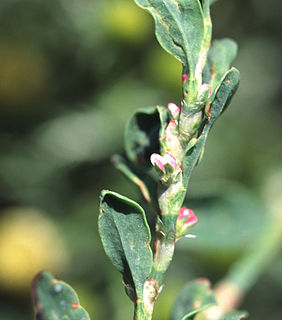
Polygonum arenastrum, commonly known as equal-leaved knotgrass, is a summer annual flowering plant in the knotweed family Polygonaceae. Other common names include common knotweed, prostrate knotweed, mat grass, oval-leaf knotweed, stone grass, wiregrass, and door weed, as well as many others. It is native to Europe and can be found on other continents as an introduced species and a common noxious weed. Knotweed was first seen in North America in 1809 and is now seen across much of the United States and Canada.
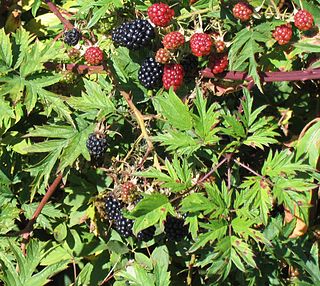
Rubus laciniatus, the cutleaf evergreen blackberry or evergreen blackberry, is a species of Rubus, native to Eurasia. It is an introduced species in Australia and North America. It has become a weed and invasive species in forested habitats in the United States and Canada, particularly in the Northeast and along the Pacific Coast.
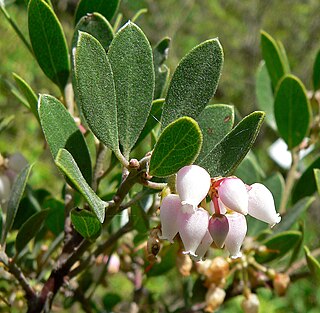
Arctostaphylos hookeri is a species of manzanita known by the common name Hooker's manzanita.
Helianthus ciliaris is a species of sunflower known by the common names Texas blueweed and yerba parda.

Heterotheca sessiliflora is a species of flowering plant in the daisy family known by the common name sessileflower false goldenaster. It is native to California, Sonora, and Baja California.

Hypochaeris glabra is a species of flowering plant in the dandelion tribe within the daisy family known by the common name smooth cat's ear. It is native to Europe, North Africa, and the Middle East but it can be found on other continents where it is an introduced species and a widespread weed. It has become widespread in Africa, southern and southeastern Asia, Australia, and parts of the Americas.

Cestrum parqui, commonly known as palqui, green cestrum or willow-leaved jessamine, is a species of flowering plant native to Chile. In Australia the plant is regarded as a noxious invasive weed and a significant hazard to livestock which may eat it inadvertently or during shortages of other foods, often resulting in death.

Allium hickmanii is a rare species of wild onion known by the common name Hickman's onion. It is endemic to California, where it is known from Monterey, Sonoma, Kern, and San Luis Obispo Counties.
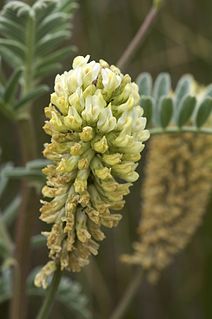
Astragalus pycnostachyus is a species of milkvetch known by the common name marsh milkvetch. It is endemic to the coastline of California, where it grows in wet saline habitat such as marshes.

Enceliopsis covillei, known by the common name Panamint daisy, is a rare North American desert species of flowering plant in the daisy family.
Lessingia arachnoidea is a rare species of flowering plant in the daisy family known by the common name 'Crystal Springs lessingia'. It is endemic to California, where it is known from a few occurrences in the vicinity of Crystal Springs Reservoir on the San Francisco Peninsula and southward to serpentine soil in Woodside. It may also exist in Sonoma County to the north. The plant grows in chaparral, scrub, and other local plant communities, often on serpentine soils.

Acmispon argophyllus, synonym Lotus argophyllus, is a species of legume native to California and northwest Mexico. It is known by the common name silver bird's-foot trefoil or silver lotus.
Polygonum marinense is a rare North American species of flowering plants in the buckwheat family known by the common name Marin knotweed. It is endemic to California, where it is known from just a few locations north and east of San Francisco Bay.
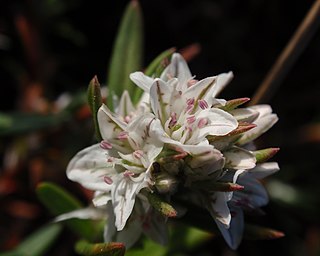
Polygonum paronychia is a species of flowering plant in the knotweed family known by the common names dune knotweed, black knotweed, and beach knotweed. It is native to the coastline of western North America from British Columbia to California, where it grows in sandy coastal habitat such as beaches, dunes, and scrub.

Ribes quercetorum is a species of currant known by the common names rock gooseberry, oak gooseberry and oakwoods gooseberry. It is native to the mountains and hills of California from the San Francisco Bay Area south into Baja California and east into Arizona.

Sporobolus foliosus is a species of grass known by the common name California cordgrass. It was reclassified from Spartina foliosa after a taxonomic revision in 2014. It is native to the salt marshes and mudflats of coastal California and Baja California, especially San Francisco Bay. It is a perennial grass growing from short rhizomes. It produces single stems or clumps of thick, fleshy stems that grow up to 1.5 meters tall. They are green or purple-tinged. The long, narrow leaves are flat or rolled inward. The inflorescence is a narrow, dense, spike-like stick of branches appressed together, the unit reaching up to 25 centimeters long. The lower spikelets are sometimes enclosed in the basal sheaths of upper leaves.

Deinandra fasciculata, known by the common names clustered tarweed and fascicled spikeweed, is a species of flowering plant in the daisy family native to western North America.

Isolepis prolifera is a species of flowering plant in the family Cyperaceae that grows in temperate regions of the Southern Hemisphere. It has leafless stems up to 90 cm (35 in) tall, and clusters of flowers that often proliferate into branches.

















